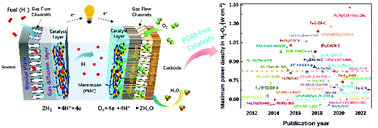Recent advances in non-precious metal electrocatalysts for oxygen reduction in acidic media and PEMFCs: an activity, stability and mechanism study
Abstract
The high cost and limited supply of platinum has driven intensive research into the use of non-platinum group metals (PGM-free) as cathode oxygen reduction reaction (ORR) catalysts for proton exchange membrane fuel cells (PEMFCs), which is crucial in promoting the large-scale applications of PEMFCs and the most important step to achieve the DOE ultimate stack cost target. As the most promising group of PGM-free ORR catalysts, the metal/N/C (M–N–C) catalysts have been extensively explored. However, several problems still exist in the development of high-performance M/N/C catalysts, including limited intrinsic activity and durability, severe concentration polarization and ohmic polarization. Therefore, our aim is to conduct a comprehensive understanding and recognize the strengths and weaknesses of the state-of-the-art PGM-free ORR catalysts for PEMFCs. Herein, we summarize three classes of the most active M/N/C ORR catalysts, namely, conductive PANI-based catalysts and their analogues, ZIFs-based catalysts and their derivatives, and other high-performance ORR catalysts, thoroughly expound their deactivation mechanisms, and deeply discuss the oxygen reduction mechanisms and approaches for identifying active sites. The challenges and perspectives on PGM-free cathode catalysts of PEMFCs are also discussed.

- This article is part of the themed collection: Green Chemistry Reviews


 Please wait while we load your content...
Please wait while we load your content...